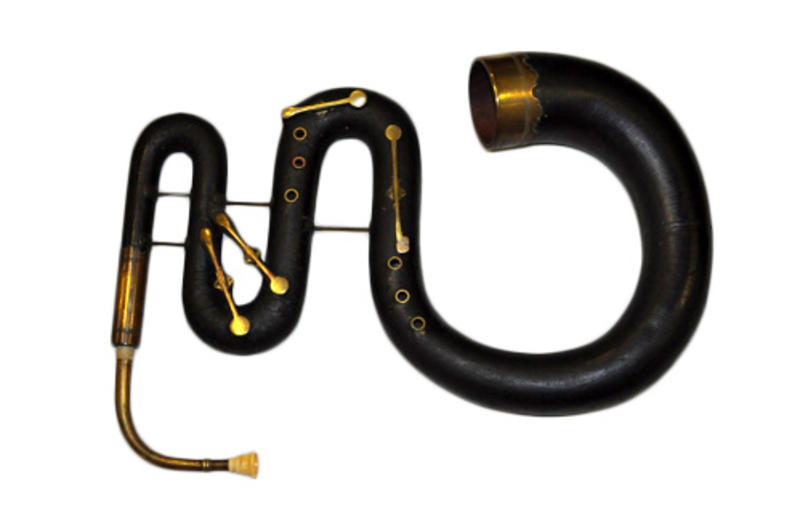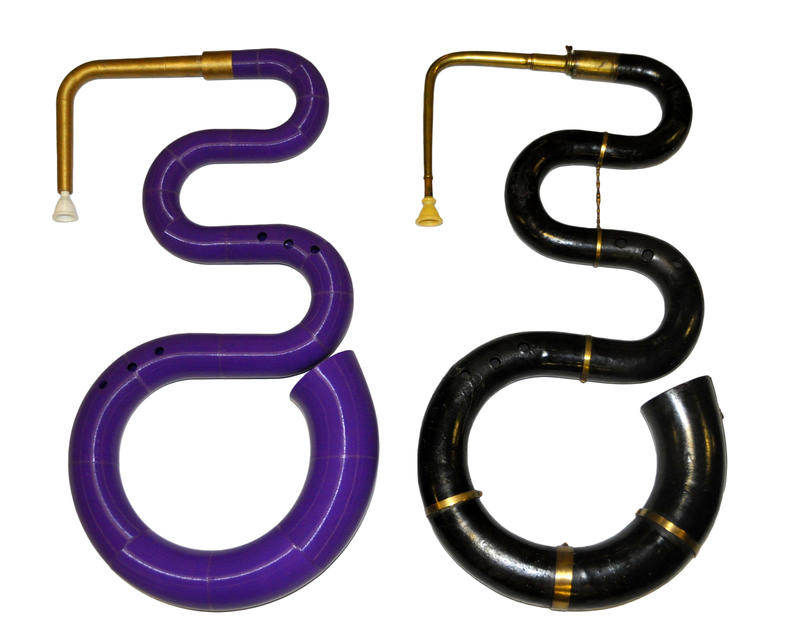Serpents
The serpent is an early form of bass wind instrument, descended from the cornett, and a distant ancestor of the tuba. It is classified as a “labrosone”, meaning it has a brass-style mouthpiece. Like the cornett, it has side-holes. It is usually constructed in an “S-bend” formation with a snakelike shape. It is usually made out of wood and covered in dark leather. However, there have been a number of variations made of different materials. Nowadays instruments are also made of plastic.
It was initially developed in France in the late 16th century to accompany church plainsong. Since that time variants have been introduced into orchestral and band music. Famously, Berlioz scored for the instrument in a number of compositions. In recent years there has been a surge of revival of interest in the instrument with inclusion in regular festivals.
Included in the Bate Collection is an English military serpent by Thomas Key of London (Bate Collection number 505). It is fairly typical of an English style military serpent. It is of sectioned wooden construction in the classic “S” bend arrangement with all parts stapled together and then bound in linen and painted with black pitch. There are six open tone holes and seven brass keys mounted on saddles. The brass crook fits into a brass socket ferrule which bears the engraving: “KEY / 20 CHARING CROSS / LONDON ; LGL5 from 1813”. The bends are supported in plane by brass struts and the bell is angled forwards at about 40 degrees. It is complete with an ivory mouthpiece and is in mostly playable condition.
STL Files for printing a 3D serpent - Bate Collection Number 504


Introduction:
The serpent is a wood bass horn with a characteristic curved shape and six finger holes for playing. Although they look like something out of the dark ages, they were invented in 1590 by Canon Edmé Guillaume of Auxerre and were used for many centuries to accompany sung liturgy in French churches. When played softly the serpent complements the human voice extremely well. When played more loudly the serpent provides a solid bass line and they were introduced into military bands from about the 1750s onwards being used extensively throughout Europe and in the USA until the 1830s.
Serpents are one of the most easily recognised and memorable musical instruments in any historic collection, and most collections will hold several examples, the Bate Collection has a dozen in various forms (some are shown in Figure 2). However, the serpent does not fit well into the modern orchestra and these instruments fell into disuse and languished in obscurity, unloved, for more than a hundred years until the early music revival of the 1970s. There is now a surprisingly active body of serpent players and enthusiasts1 and a good choice of playable replica instruments are available, at a price. Due to its sinuous shape and complex form the Serpent is perhaps ideal for 3D printing technology.
This 3D printed instrument described here is modelled on an example of a French church serpent produced by an unknown craftsman and which was very probably made in the early 19th century. It is currently held in the Bate Collection in Oxford (inventory #500). The original instrument was modelled using RS DesignSpark Mechanical, a free to use CAD (Computer Aided Design)2 package to create the printable object. The body of the prototype instrument was printed in 20 sections on an Ultimaker2 3D printer at the Imperial College Advanced Hackspace (http://icah.org.uk) and the parts assembled by gluing. The mouthpiece and bocal (mouthpipe) add an extra six parts.
Extract from: 3D Printing the Bate Serpent by Mark Witkowski
A guide to downloading, 3D printing and assembling the Bate Collection Anon Serpent model.




